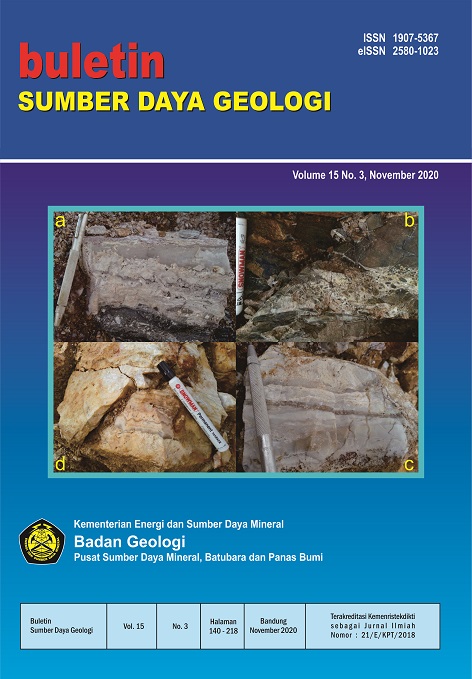KARAKTERISTIK ALTERASI DAN TEKSTUR URAT KUARSA PADA PIT BARANI, CEBAKAN EMAS MARTABE, KABUPATEN TAPANULI SELATAN, PROVINSI SUMATRA UTARA
ALTERATION AND QUARTZ-VEIN TEXTURES CHARACTERISTIC AT BARANI PIT OF MARTABE GOLD DEPOSITS, SOUTH TAPANULI REGENCY, NORTH SUMATRA PROVINCE
Abstract
Barani Pit is part of the PT Agincourt Resources Contract of Work, located in Aek Pining Village, Batangtoru District, South Tapanuli Regency, North Sumatra. The Barani Pit is an open pit mine, with epithermal deposit type in the form of veins which host for more concentration of metal elements. This study aims to find out the alteration characteristics and texture variations of quartz veins that are abundant in the Barani Pit area and to identify the texture of quartz veins carrying economic mineralization. The pit mapping method is used to get samples, and alteration mineral identification using analytical spectral devices (ASD), as well as geochemical analysis to determine grade content of Au, Ag, and Cu elements. The results showed that the developing alteration zone consisted of argillic (kaolinite+illite+ smectite), advanced argillic (quartz+kaolinite+dickite), and silicification (quartz+chalcedony+ kaolinite). Quartz textures of the veins that developed in the study area consisted of massive quartz, crustiform, crustiform-colloform, brecciated, bladed, and saccharoidal. The texture of mineralization bearing veins with high grade gold content were crustiform-colloform, banded, followed by massive quartz oxide, and lattice bladed. These veins are associated with kaolinite + dickite clay minerals, moderate to high oxidation states, and are associated with grey sulphides containing high grade up to Au 76.65 ppm and Ag 34 ppm.
Downloads
References
Alderton Conrad. 2017. Description and Comparison of the Martabe Deposits. Martabe Deposits Final, Internal Report Martabe, p. 20 – 24.
Anonim. 1996. Sandi Stratigrafi Indonesia, Komisi Sandi Stratigrafi Indonesia. Ikatan Ahli Geologi Indonesia, 14 h.
Anonim. 2009. AusSpec Workshop: Spectral Analysis and its Application to Exploration and Mining. AusSpec International, internal presentation.
Corbett, J.G., and Leach, T.M., 1997, Southwest Pacific Rim gold-copper systems: Structure, alteration, mineralization: Society of Economic Geologist Special Publication, v.6, p. 98 – 102.
Davies, B., 2002. Report on the structural review of the Martabe project, Newmont Horas Nauli, internal memorandum, p 5.
Dong, G., Morrison., G and Jaireth., S., 1995. Quartz Texture in Epithermal Veins, Queensland – Classification, Origin, and Implication: Economic Geology, vol 90, p. 1841 – 1856.
Dowling, K. and Morrison, G. W., 1990. Application of quartz textures to the classification of gold deposits using North Queensland examples: Economic Geology, pp 342 – 355.
Hedenquist JW, Arribas A Jr, Reynolds TJ.1998. Evolution of an intrusioncentered hydrothermal system: Far Southeast Lepanto porphyry and epithermal Cu-Au deposits, Philippines. Economic Geology, 93 (4) p 373-404.
Morrison, G., Guoyi, D., dan Jaireth, S., 1990. Textural Zoning in Epithermal Quartz Veins. Klondike Exploration Services, p. 35.
Sutopo Bronto, 2013. The Martabe Au-Ag High-Sulfidation Epithermal Deposits, Sumatra, Indonesia: Implications for Ore Genesis and Exploration. University of Tasmania: Australia, p. 332.
Copyright (c) 2020 Buletin Sumber Daya Geologi

This work is licensed under a Creative Commons Attribution-NonCommercial-ShareAlike 4.0 International License.
Authors whose manuscripts are published agree to the following terms:
The publication rights of all journal manuscript materials published on the Buletin Sumber Daya Geologi website are held by the editorial board with the knowledge of the author (moral rights remain with the manuscript’s author).
The formal legal provisions for access to digital articles in this electronic journal are subject to the terms of the Creative Commons Attribution-ShareAlike (CC BY-SA) license. This means that Buletin Sumber Daya Geologi has the right to store, convert media/formats, manage in the form of a database, maintain, and publish the article without requesting permission from the author, as long as the author’s name is cited as the copyright holder.
Manuscripts published in both print and electronic formats are open access for educational, research, investigative, and library purposes. Beyond these purposes, the editorial board is not responsible for any violations of copyright law.















